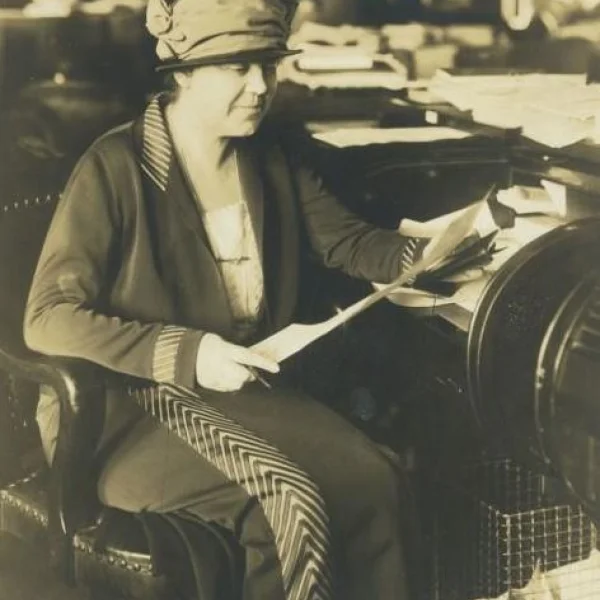On August 26, 1920, U.S. Secretary of State Bainbridge Colby signed into law the 19th Amendment granting women the right to vote. The intentionally muted signing ceremony—held at Colby’s personal residence no less—marked the end of an arduous journey toward women’s suffrage dating to the anti-slavery movement in the decades before the Civil War.
Bloomington was never a hotbed of suffragist sentiment, yet beginning in the early 1870s and through the next half century there existed on the local scene measured support for the enfranchisement of women. From time to time, Bloomington hosted lectures, debates, organizational meetings and conventions, all relating to suffrage. Furthermore, the pages of The Pantagraph and the city’s other newspapers were occasionally peppered with lively exchanges between those who supported and those who opposed (with men and women on both sides) the right of the “fairer sex” to vote.
Illinois’ statehood constitution of 1818 limited voting to “white male inhabitants,” and the state’s third constitution (ratified in 1870) enlarged the franchise to include African-American males, though calls to expand that fundamental right to women fell on deaf ears.
In March of that year, 1870, suffrage titan Susan B. Anthony debated Illinois State Normal University Professor Edwin C. Hewett before a packed crowd at Schroeder’s Opera House in downtown Bloomington.
Almost two years later, February 1872, the Illinois Woman Suffrage Association held its convention at the same location. The statewide group’s executive committee featured three women from Bloomington—Barbara Prince, Jane Fell and Frances Hogg. Out-of-state speakers at this meeting included Mary Adelle Hazlett, the “little wolverine” from Michigan, and Susan Anthony, back once more and still tirelessly fighting the good fight. “She speaks like lightning and cuts and slashes in every direction,” The Pantagraph said of Anthony.
Dr. Ellen B. Ferguson, a Bloomington physician and proto-feminist, inveighed against the principle of taxation without representation. She also spent part of her half hour speech denouncing the “frivolity of fashionable life.” Ferguson told the gathered suffragists that girls are “educated too much in the direction of finery and feathers and not enough in the direction of useful information and the knowledge of how to take care of themselves.” Preaching self-sufficiency, she said that many local girls could “grow up to be magnificent specimens of womanhood if they were to leave the realm of fashion.”
By 1873, the Illinois legislature OK’d women to hold elected offices relating to public education, though they were still prevented from voting in these or any other races. Even so, by the following year Illinois could boast of having 10 female county school superintendents elected by male voters.
Finally, in 1891, the Illinois General Assembly granted women the right to vote in school elections. As a result, the Monday, April 4, 1892, election of two Bloomington Board of Education members (though both male) marked the first time women could vote in the city. For its part, The Pantagraph called this historic event the “most remarkable, interesting, and in many respects exciting, election which has ever occurred in Bloomington.”
With early morning rains threatening voter turnout, Mary Ward, “clad in gossamer and galoshes and holding a dripping umbrella,” became the first woman to cast a vote in a Bloomington election. By the time the weather improved, the line of first-time voters extended out the County Courthouse (where the segregated-by-sex ballot boxes were located) and down Main Street. “None of the lady voters yesterday smoked, chewed tobacco or drank whiskey while waiting in line,” The Pantagraph joked. “No wonder some people don’t want women to vote.”
Women comprised nearly one-quarter of the electorate that day. “The gentle sex descended on that single ballot box like an avalanche,” concluded The Pantagraph.
At long last, the landmark Illinois Municipal Voting Act of 1913 gave women the right to cast ballots in all elections not specifically referenced in the state constitution. This meant that Illinois was the first state east of the Mississippi River to allow women to vote in presidential contests. And on June 10, 1919, Illinois became the first state (beating Wisconsin by an hour) to ratify the 19th Amendment, which would end all remaining state roadblocks to full voting rights.
In 1923, Lottie Holman O’Neill of the DuPage County community of Downers Grove became the first woman to serve in the Illinois House of Representatives, and two years later, Florence Fifer Bohrer (see accompanying image), a fellow Republican from Bloomington, became the first woman to occupy a seat in the state senate.

